I actually took all of these photos before I shot the fossil rock for the previous post, but I intentionally posted them in this order to break things up a bit. It probably doesn’t help, but I get credit for the effort, right?
 After the heavy rains Monday night and Tuesday morning, I went out to do a walk-through of the yard, and one of the first things I noticed was what you see here, a leaf of a sea oat plant (I believe, anyway) that had been rolled into this shape. I am quite sure that this had happened within the past several hours because it had not been this way when I went past earlier – the plant has been playing host to a few resident insects so I’m pretty familiar with it. Several different arthropods will do things of this nature, for differing reasons, but this one wasn’t hard to figure out at all, only requiring a peek down the end of the tube.
After the heavy rains Monday night and Tuesday morning, I went out to do a walk-through of the yard, and one of the first things I noticed was what you see here, a leaf of a sea oat plant (I believe, anyway) that had been rolled into this shape. I am quite sure that this had happened within the past several hours because it had not been this way when I went past earlier – the plant has been playing host to a few resident insects so I’m pretty familiar with it. Several different arthropods will do things of this nature, for differing reasons, but this one wasn’t hard to figure out at all, only requiring a peek down the end of the tube.

A jumping spider (unknown species, family Salticidae) had created a shelter by attaching webbing to the edges of the leaf and pulling it into this shape. Curiously, I’d seen this particular one less than two meters away the night before, recognizing from her swollen abdomen that she would be laying eggs soon. Naturally, I wish I’d been able to watch her make this shelter; this would require a lot of time spent simply following a spider around on her perambulations, with the very real possibility that she never would have started construction with the threat of a nature photographer hovering about. Plus I’m not sure I have the patience.
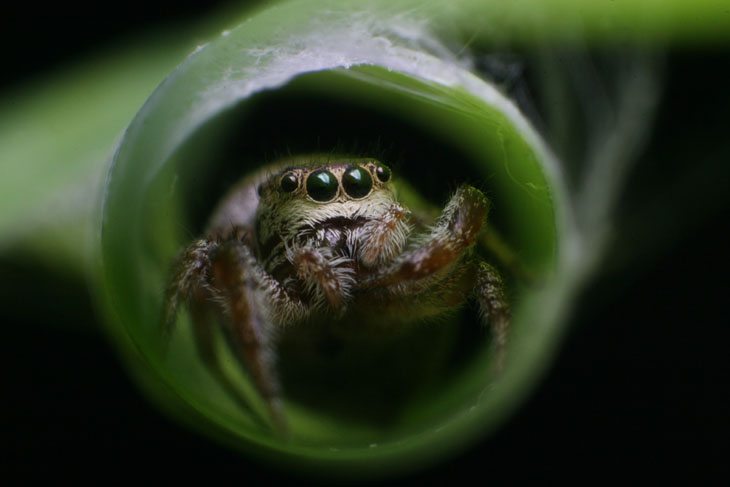
But since this is on a potted plant, I can probably follow along with progress from this point on, watching for the egg sac to appear and seeing how long it takes for them to hatch. The adult is in the range of a centimeter in length, so the newly-hatched young are going to be tiny. If it works out I will, of course, fill the blog full of more icky pictures.
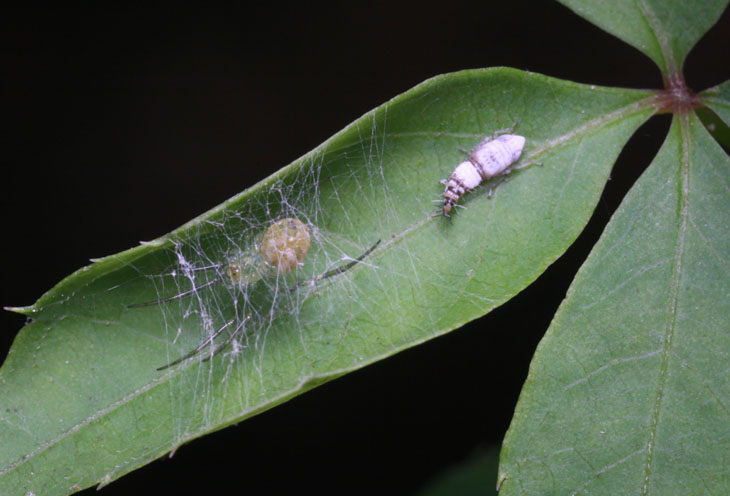
On a Virginia creeper vine (Parthenocissus quinquefolia) along the fence I found another shelter, this one not quite as concealing – and a close companion. The spider is most likely genus Mangora, though which species has yet to be determined (it’s very reluctant to give me a good look at identifying characteristics.) I know this will be a shock to you, but I went in for the portrait shot like I did with the jumping spider.
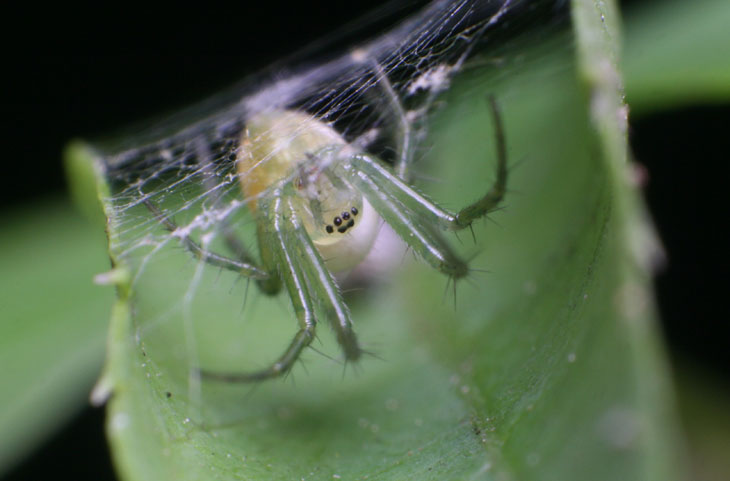
Going out later at night to try and gain more identifying characteristics, I discovered this one dangling from a short length of web beneath this shelter leaf, right alongside its newly-molted exoskeleton. Unfortunately, in setting up a light to be able to focus usefully, the spider panicked, dislodging the molted skin and scrambling back up to the shelter again.
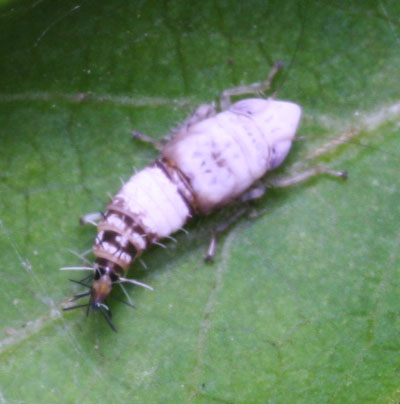 What I took to be a lacewing nymph nearby was, on close examination, a disguised leafhopper nymph, possibly a sharpshooter of some type. The tail is to the lower left, but I had taken this for the head, and it was contributing to this impression by waggling it slowly back and forth like a caterpillar foraging. When I looked at the images I’d gotten (this is a crop of the other photo further up) and realized I should get more detailed shots, the bugger had wandered off and was nowhere to be found on the vine or fence. You’d think it was sooo much to ask for a little cooperation…
What I took to be a lacewing nymph nearby was, on close examination, a disguised leafhopper nymph, possibly a sharpshooter of some type. The tail is to the lower left, but I had taken this for the head, and it was contributing to this impression by waggling it slowly back and forth like a caterpillar foraging. When I looked at the images I’d gotten (this is a crop of the other photo further up) and realized I should get more detailed shots, the bugger had wandered off and was nowhere to be found on the vine or fence. You’d think it was sooo much to ask for a little cooperation…
As usual, I’m keeping close tabs on the various mantids around the yard – the count had been up to five, though two have moved to different locations now and one, a tiny specimen that I suspect is a different species, hasn’t been seen for a few days. I suppose I could rename this blog to something mantis-related, seeing as how the tags of “Chinese mantis” and “Tenodera aridifolia sinensis” (the scientific name) are the most-used on the blog, but then I couldn’t feature treefrogs and religion-bashing. Better keep it the way it is. But anyway, after getting all of these shots I wandered out front to check on the mantids, without any intention of photos since I have a million. But one of them was in possession of a newly-captured black ant, still struggling in its clutches, so naturally…

When it saw me, the mantis scrambled for cover, but not very far, and as I leaned in closer it ignored me in favor of its meal, so yeah, the mantids are cool at least. The mantis was completely unconcerned with dispatching its meal before starting in, so the ant was struggling throughout this whole photo sequence.
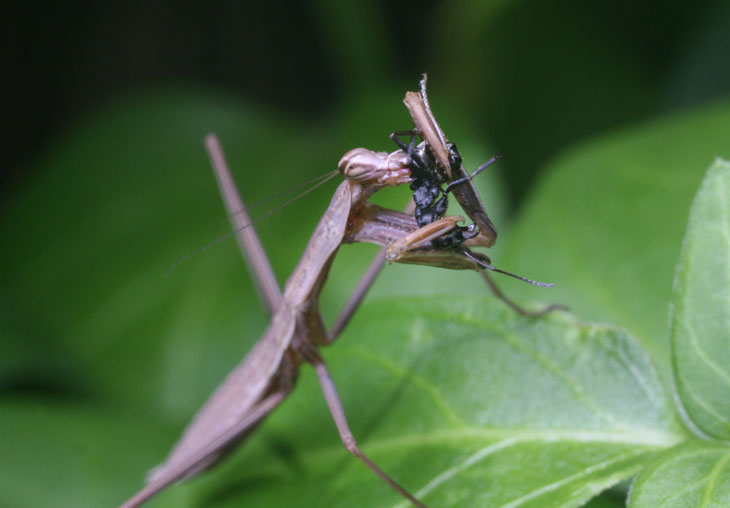
I have yet to determine what governs the coloration of mantises. This one had been hanging out on the Japanese maple tree, which is deep reddish brown right now, before moving to the phlox underneath that you see here. It has remained this tan color for at least one molt, probably more. Another on the same tree, slightly bigger than this one, has remained a brilliant green, well able to blend in with the phlox but so far never seen on it at all. Well, here – why describe it when I can illustrate it?
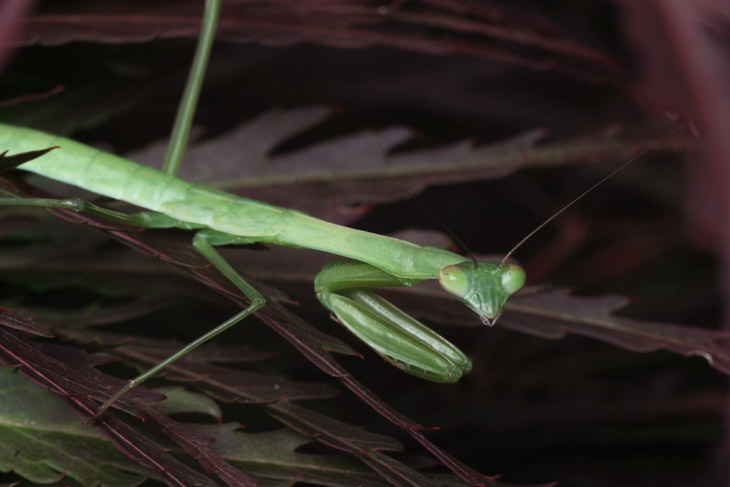
I used to think that they’d change color at molting to something that blended better, but the evidence is pretty strongly against this in my experience, so feel free to enlighten me.
Now let’s get back to the slaughter.
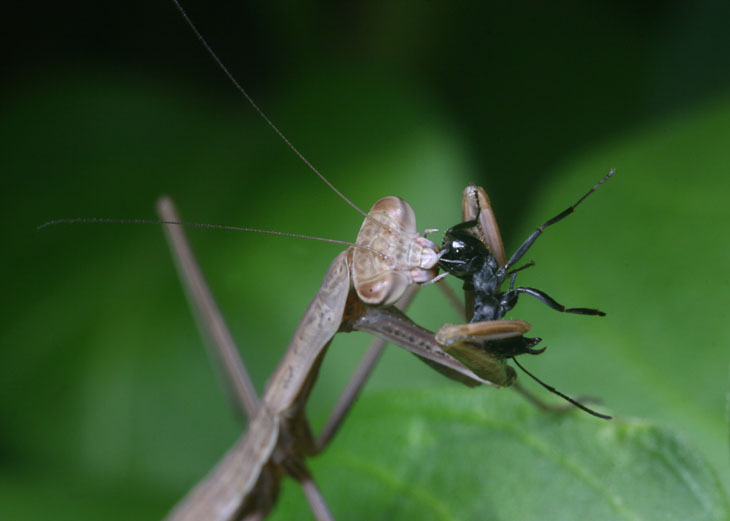
I got just enough frames for good detail, then left my subjects in peace (or pieces as the case may be.) I know that things tend to whittle down the mantis numbers routinely, and of course last year a stupid deer blithely dispatched my last subject, so I’m just going to keep an eye on things as they go along. Such is wildlife.



















































